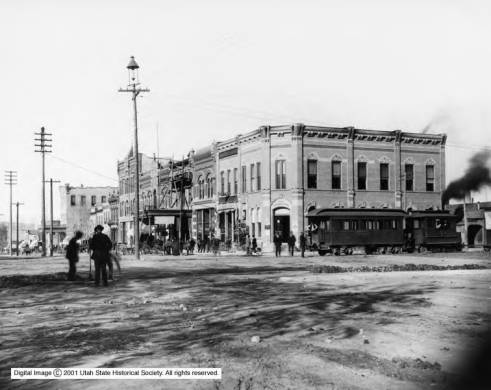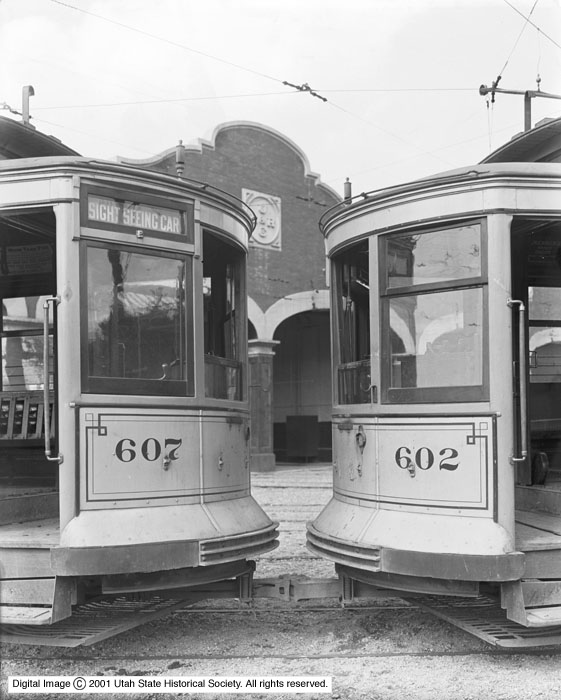-----
 |
| A SL&U Hall-Scott motor car arrives in Orem, Utah, 1913. (Daily Herald) |
A.J. and Walter C. Orem were already well known in the Utah Railroading circles as financiers and railroad constructors. The two brothers made their money in mining roads and were based out of Boston, Massachusetts, with Walter in charge of directing the company's funds. One project that caught Walter's keen eye was a possible electric interurban route between Zion and the Utah Valley, so he immediately leapt into the project with his friend, governor of Utah and fellow electric railway magnate, Simon Bamberger. Walter was granted a franchise for this new railroad on August 8, 1912, and would arrive in Utah in September to tour the new route by car.
 |
| The 1916 Payson Celeberation, using street trackage and an errant flatcar. (The Daily Herald) |
As Walter and Gov. Bamberger went from Zions Park to the railroad's eventual terminus in Payson, some 60 miles via Interstate 15 today, the newspapers lauded the tour and stirred up public excitement in the project. Due to the lack of a name, they speculated on what it could be and proposed a few names: The Salt Lake & Utah Valley Railroad, The Salt Lake & Payson Railroad, or more popularly, The Orem Line. At the end of Walter's auto tour, he and Gov. Bamberger agreed the route was feasible and ponied up $2 million out of a $3 million dollar price tag to fund construction, with Zions Park business owners offering the rest. The entire railroad would cost $78 million in 2020 dollars.
Unfortunately, rivals were already interfering at that very same time. At the end of September, Montana banker John MacGinnis (not the first time a "McGinnis" would interfere in railroading) and Spokane telephone magnate Thaddeus Lane made themselves known as the "Utah Interurban Electric Company" (UIE) with the intent to undercut the SL&U in costs, shaving off a cool $1 million. To ensure they had a leg up on the SL&U, UIE engineers would wait until December to officially announce the railroad.
 |
| Downtown Provo in 1890, with steam dummy streetcar service (ProvocationUtah) |
Under the "Interurban Construction Co. of Portland, Maine", the "Salt Lake & Utah Railroad" (they finally decided on a name) was incorporated on October 16, 1912 with a set capital stock and leadership decided. Four days later, grading had finished in Provo and construction really began, starting with a 11-block streetcar line between the Denver & Rio Grande Western Depot to Brigham Young University. The UIE was clearly not finished at this point, lining up its own franchises, so SL&U decided to cut them off using Provo's Main Street in order to hold the Orem's franchise there.
By the end of November, Provo was the official headquarters of the SL&U with forty miles of rail being delivered and laid. To celebrate this feat, the company bought three ex-Utah Light and Railway Company of Zion streetcars but it is unknown if they ever saw service in Provo. The winter was spent stockpiling materials in Provo, American Fork, and Salt Lake City, with the following spring resulting in 35 miles of track being laid from Salt Lake City, often one mile a day. In June, 1913, Walter C. Orem was chosen as the company's President and General Manager, with F. M. Orem selected as the secretary treasurer.
 |
| Two Utah Light and Railway Co. streetcars engage in a staring contest, 1911. (Shipler Commercial Photographers) |
 |
| Representation of Mrs. W.M. Smith, empowering railway women everywhere. Location is Sunnyside yard, Long Island, 1940s. (This Week in New York) |
One of the more colourful stories of the SL&U's construction revolved around Mrs. W. M. Smith, touted as the "colorful woman railroad builder of the West." She worked with the Southern, Western, and Union Pacifics all with planning various lines in Winnemucca, Fernley, and the Teton Branch, but also was an efficient and hard-nosed boss herself. She learned the business from her father, John Sheehan (who built the El Paso & Southwestern) and was using the SL&U as a chance to train her daughter, Irine. In Mrs. Smith's words, "There is good money in the contracting business and I don't see why a woman shouldn't succeed in it as well as a man. Certainly I can look along a rail and see if it is laid straight. If it isn't I make the men take it up and fix it."
The SL&U's line to Provo was set to open on January 1, 1914. The wires had not been raised yet, so the Hall-Scott Motor Company was contracted to build three motor cars for the first three months of service. The harsh winter would also delay the cars arriving in Salt Lake City, instead departing the Berkeley factory the first week of February on their own power (a distance of 728 or so miles). The new "temporary" terminus in Salt Lake City (shared with the Bamberger Railroad) was bodged out of corrugated iron but contained all the furnishings needed. American Fork would get a larger, more substantial concrete building.
 |
| Three SL&U cars sit at the more permanent Salt Lake City station (behind), October 1945 (Robert Richardson, Donstrack) |
 |
| Salt Lake & Utah 604's builder's photo from the Niles Car Co. (Don Ross) |
 |
| An SL&U timetable from 1945. (Public Domain) |
Unfortunately the happiness would end just after World War I. The Provo Streetcar would close in March 1919 after reporting a daily income as low as twenty cents and increased auto passenger and freight traffic put the line in dire straits. By July 24, 1925, the SL&U was sold to new receivers and Walter Orem was demoted to Comptroller. Profits managed to pick up by the turn of the Depression, and the SL&U was starting to be seen in a more favorable light compared to the Bamberger Railroad, which by this point was a shell of itself. Service was so good that cars from both the Bamberger Railroad and the Utah-Idaho Central (formerly the Ogden Rapid Transit Co.) were frequently borrowed to keep up with service.
 |
| A Hall-Scott Motor Car streaks by the camera on the SL&U (Dave England, Donstrack) |
 |
| A big red car for freight service? Where have I seen this before? (Gordon Cardall, Donstrack) |
-----

No comments:
Post a Comment